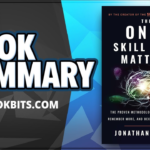★DOWNLOAD THIS FREE PDF SUMMARY HERE
? MY FREE BOOK TO LIVING YOUR DREAM LIFE”
? SPONSOR BESTBOOKBITS BY USING PATREON
? SUPPORT BESTBOOKBITS BY CLICKING THE LINKS BELOW
- 150 PDF Summaries
- Coaching Program
- Subscribe to My Channel
- Website
- Spotify
- Book Club
- Mailing List
Bullet Summary
- Disruptions create a new market and business model
- One disruption spawns a wave of disruptions as it propagates to different markets
- You can profit without inventing by applying a disruption to new markets or creating ancillary services/products
- Other people’s money is the best funding. To tap it create opportunity for others with your product
Full Summary
Jay Samit calls disruption the intense introspective process of questioning his assumption about himself and his goals. With self-disruption he realized he could accomplish what he before thought impossible. And he realized two things:
- If he can express problems as series of challenges he can build a team to meet those challenges
- business don’t sell products; They sell solutions.
Jay Samit says that the mentality of disruptors is that of seeing obstacles as opportunities Disruptors constantly reinvent themselves and their careers and are never afraid of losing their jobs because they create jobs. To become a disruptor, you don’t an MBA or an engineering degree. You simply need to think like a disruptor. Disrupt You! is Samit’s way of teaching us how they do it.
Chapter 1: In Defense Of Disruption
Jay Samit says that disruption almost always happens because of technological change, but the impact of disruptions goes far beyond the technology industries.
The author talks about the laser disc in which he had invested feeling safe it would be the next revolution. It failed instead. And he learned that it failed because it tried to compete with the old technology, the VCR.
But for a disruption to happen, it must create a new market and transform the existing business model.
Samit refused to give up, and learned that failing is trying something that doesn’t work while failure is throwing in the towel. And he refused to be a failure.
The author says that big disruptions often set out a chain of disruptions. For example cloud computing, wearable technology, 3-D printing etc are providing the chance of making a fortune with hundreds of related applications of the new tech. Sometimes in the simplest way. For example while every entrepreneurs were busy coming up with complex computer systems in the ’90s, Samit’s friend Billy made a fortune selling mouse pads and plastic floppy disc containers. With a big disruption under way, you should apply your unique experience and viewpoint to look for opportunities in parts of the market that others have overlooked.
With his own company Samit looked how the personal computers were disrupting non-technology related business. Since he came from advertising, he applied his own point of view to sell the first CD-ROM with stock photos in it. The stock photo companies hadn’t realize the big opportunity that lied in the CD-ROM. In a period of endless disruptions, says Samit, the secret to thriving as a disruptor is this: Use an existing technology to disrupt a different business. A wealthy disruptor then is the one who captures the value which is released by disruption.
The chapter ends saying that your corporate job isn’t really secure. And it’s not security that robs ambition, it’s the illusion of security that robs ambition.
Chapter 2: Become A Disruptor
Jay Samit says that being a disruptor is a state of mind.
It’s looking at opportunities in the obstacles you face, to respond to setbacks as if they were new beginning and, he says, it’s being the silver-lining business.
The author says that every person who has transformed a business started with a personal problem and then took note of how many others shared the same problem.
Branson started Virgin when he noticed how many stranded people were at the airport and he chartered a plane. The girl who started the dresses for rent noticed how many girls shared her problem of wanting a top designer dress but couldn’t afford to buy it. And the man who started an online university noticed how many students were drowning in debt.
All these people shared a disruptor mindset.
Instead of waiting for someone else to solve the problem or to suffer in silence, they jumped in headfirst. Massive problem equals massive opportunity.
THE ART OF SELF-DISRUPTION
Jay Samit quotes the Buddha when he says that “the mind is everything. What you think, you become”. He says you must remove all definitions of self, internal or external, that limit your progress. Self disruption is like undergoing surgery, but you are the one self-operating. It’s not a comfortable process and it requires getting out of your comfort zone.
The author uses the same value chain links used to describe businesses to describe our own personas:
- R&D: takes input from environment and sees them as obstacle or opportunity. Annihilate all beliefs holding you back.
- Design & Production: our actions in response to our perceptions. Avoid baby steps, train to see the big picture, go from solution to where you stand now
- Marketing & Sales: do something you never thought you could do, that’ll change your perception of what’s achieavable
- Distribution: how we spend our time and direct our focus, think of how you can become more effective and do more of what you love and moves you towards your goals
Jay Samit focuses a lot on the beliefs we hold and how they influence us. He mentions the Matthew Effect, Children who are told they are smart do better.
Basically, you get what you believe you deserve.
The author also recommends to visualize and I recommend you get the book for his own personalized suggestions.
Chapter 3: The Disruptor’s Map
Samit stresses the importance of having a map and a plan. Think about what your want to achieve, both in your career and outside your career.
What you want to achieve and experience?
Work life balance is about choosing what’s important in your personal life and career and then place them in your map according to importance.
Planning is bringing the future into the present so that you can start working on it.
The author stresses the importance of mentors, invaluable and often crucial to disruptors’ success. He says they are easy to find, just read the blogs in your industry and you’ll quickly find the luminaries you aspire to emulate.
Last but not least, Samit urges us to get going. Time waits for no one and the number one regret of dying patients is they wished they lived according to their true self instead of following the expectations of others.
Chapter 4: Building A Brand Of One
Jay Samit talks here about personal branding.
He says for long time he believed his work should speak for itself, but he realized that’s not true. Our personal brand often speak for ourselves before we even have the opportunity to open our mouths or show our work.
A few great ideas to grow your personal branding:
- Public speaking: many conferences are desperate to find speakers, and the more niche your topic the less competition
- Certifications: especially from big brands so you can put their logo on your business card or CV
- Big brand endorsing: big publishers need people to write for them, and your story on the Huffington Post makes you a columnist
- Guerrilla marketing: having stars use your product
Particularly interesting were also the techniques Jay Samit describe for getting a dream job, such as buying adword impression for executive who are very likely to Google themselves.
Chapter 5: Disruptors At Work, The Value Of Intrapreneurship
Jay Samit says that big companies are too busy fighting other big companies to often pay attention to the future disruptors.
The author says that big organizations are built for efficiency, not innovation. Management is rewarded for achieving more of what’s already proved to be successful, and trying new paths is often a career suicide.
Also any initiative that could cannibalize or kill the existing revenue generators face strong internal headwinds. Basically, the whole culture is strongly biased towards safe and short term -which ends up being non safe in the long term-.
So big organizations prefer to overpay for a new promising startup than do the internal investment required to do the disruptions themselves. And this is all great news for the disruptors.
Most Silicon Valley millionaires indeed didn’t become millionaires by building profitable businesses, but by selling to bigger and established companies.
Disrupting From Within
Disrupting From Within
However Jay Samit still managed to disrupt from within at his stints at Sony, EMI and Warner. He says the trick is to get what you want by giving the company what they think they want.
And of course, never complain that the current management doesn’t understand you, it’s always up to you to communicate to them in a way they will get it, which is by presenting the new idea as if it were an old one.
Always pitch your novelty through the familiar lenses.
And when he received a NO to his project, Samit understood another huge lesson: you can do whatever you want in life as long as you can find someone who is willing to pay for it.
Chapter 6: In Search Of The Zombie Idea
Jay Samit says that every time you get a great idea, your task is to find a way to kill that idea. Do it yourself and early, or the marketplace will find it and you will waste time and money.
The faster you can kill bad ideas, the quicker you can pivot to successful one. Speed to fail should be every entrepreneur’s motto, says Samit.
And when you can find a big idea that can’t be killed -what he calls a Zombie Idea-, then go ahead with it.
The Big Idea
Jay Samit says that the “Eureka” moment of the big idea is a myth. Big ideas are actually easy, but they don’t come from moments of brilliance, they come from careful and methodical observation.
He says you have to look at the existing value chain that is most easily upended. Look for the link that will shift the most dollars away from the present set up.
Uber for example one link of the taxi chain: distribution, and shifts the money from thousands of small cab companies to one centralized software.
The next step is to capture as much of that unlocked value in the shortest possible time.
The author encourages his students to look at their lives and write down every problem they encounter and every possibility of disruption.
The Stealing Ideas Myth
Jay Samith says that the common misconception of keeping your great idea under cover or else someone will steal it, is baloney. If your idea is original, people will say it won’t work. If it’s not original, people will say there’s already X and Y company doing it so why should they invest in it.
Also falling in love with your great idea is silly, your goal is to kill it and attack it until what’s left is a Zombie Idea.
Chapter 7: Pivoting Your Energies
Jay Samit says that pivoting is a skill and a difficult decision. But if it has to be done, get rid of your silly emotional attachment to your original idea and change course. Staying the course too long because changing is a tacit admission you were wrong is a common mistake.
A great way to decide when the time has come is data. Data has no ego and makes an excellent copilot, the author says. It may disappoint, but it never lies.
So invite it any time you can.
Chapter 8: Unlocking The Value Chain
Chapter 8 deals with the potential of identifying links that are costing you too much and that can be safely discarded. For example Cirque du Soleil got rid of the animals which were the most expensive link and focused on the most profitable and value adding parts of the show.
Chapter 9: R&D – Unlocking The Value Of Waste
Chapter 9 of Disrupt You! repeats the key idea that disruptors don’t have to discover something new but only discover a practical use for new discoveries.
Jay Samit says there are billions and billions worth of research in universities that could yield to huge new disruptions. And major disruptions under way only looking for new uses. You only need to look.
And if you don’t know where to start, you can crowdsource the development of your invention. A website like Quirky is such an example for bringing the product to market via crowdsourcing.
Chapter 10: Design – Disruption Through Aesthetics
Design disruption focuses on the art of simply building something better.
Chapter 11: Production – Reuse, Repurpose, Re-Create
Jay Samit stresses again that for an innovation to be successful it must not just create value, but capture it -unless world improvement is your goal, then you have Wikipedia and Craiglist that only displace industries without capturing the value-.
With his company Jasmine Samit was making money only when he was hired to produce courses. He was like the old scribes before Gutenberg invented the movable printing press.
Then he contacted his big customers brands and proposed to sell their courses to other brands with their logo in it and he’d give them a revenue share. Now Samit was making money even while sleeping.
He talks about the revolution 3D printing will unleash and how the copyright laws will be easily circumvented again by everyone who wants to.
Those who will cling to the status quo, will lose. Those who recognize the inevitability of such changes stand to benefit the most.
Chapter 12: Marketing & Sales
Differentiation and disruption in the sales model can be as revolutionary and disruptive as the product itself, says Samit.
The challenge is not in coming up with a new and creative marketing campaign, but rather in developing completely new sales strategies, channels, and business models. Differentiation of the sales model can be as powerful as differentiation of the product itself.
I invite you to read the book for further examples.
Chapter 13: Distribution – Unattained Value
Physical dollars have been replaced by digital dimes in many industries, and yet several companies have figured out a successful model allowing them to capture the greatest value.
They did it through distribution while disrupting the producers’ ability to maintain profit margins.
Distribution, Samit says, seems to be the higher value link in the digital age.
Amazon, eBay and iTunes squeezed the producers’ profits and amassed a fortune for themselves.
And a new generation of entrepreneurs is connecting the world without ever having to create any content themselves.
Chapter 14: Capital Revisited – Other People’s Money
I love Samit’s take on Other People’s Money (OTM).
Venture capital and borrowing can be great way of expanding your startup, but whenever you can OTM beats them all. To use OTM you need to create opportunities for those who have more capital than ideas and entrepreneurial wherewithal. It’s your chance to monetize your creativity and go-getter attitude.
In a nutshell, the secret to use OPM is to find someone else’s problem and make your product their solution.
The secret to OPM is to find someone else’s problem and make your product their solution.
When working for Sony and trying to launch the company’s own e-store for music and against the much more powerful iTunes, Samit managed to get free partnerships with rock events and McDonald’s.
Especially the partnership with McDonald’s was not easy and had a crazy twist in the end. The way Samit solved it is genius and I invite you to read the book for it.
Chapter 15: Disruption In The Era Of The Crowd
Samit says that the easiest industries to disrupt are those where inefficiency is your only competition. The example is the real estate industry, where investing was complex and time demanding.
Websites and services allowing investors to simply put a small chunk of money in projects of their choices easily disrupt an industry that was so inefficient at its core.
Chapter 16: Disrupt The World
The last chapter is about the disruptive process and attitude applied not just to industries but to countries and political regimes.
The example Samit uses are the Arab Spring and the Syrian revolt again Assad, albeit I’m not too sure that applies well seeing the results in hindsight.
Jay Samit makes a last great example with bottle recycling though. He says passing the bill to recycle used plastic bottle seemed so very difficult because of entrenched benefits.
But when the bill gave potential new profits to the local bottlers, it became immediately easier and embraced by everyone in the industry. The message is that to solve a disfunctional political systems a business approach may be needed.
My note: also on top of a business approach, it’s a human approach that is needed. The example was, after all, a simple application of the rule of social exchange.
Epilogue: The Self-Disruptor’s Manifesto
Jay Samit reminds us that to change the world we first have to start with ourselves. And once we do that our future and the world future are far more malleable than we realize.
★DOWNLOAD THIS FREE PDF SUMMARY HERE
? MY FREE BOOK TO LIVING YOUR DREAM LIFE”
? SPONSOR BESTBOOKBITS BY USING PATREON
? SUPPORT BESTBOOKBITS BY CLICKING THE LINKS BELOW
- 150 PDF Summaries
- Coaching Program
- Subscribe to My Channel
- Website
- Spotify
- Book Club
- Mailing List
2 comments on Jay Samit: Disrupt Yourself Book Summary
Leave a Reply
You must be logged in to post a comment.














Thanks for writing such a detailed summary and spreading the message of Disrupt Yourself.
Thanks Jay, Loved the book